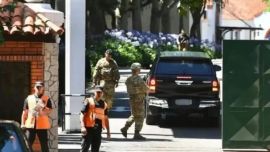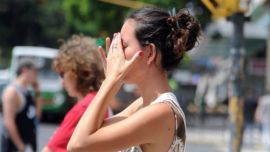Private consultants have touched up their calculations and now project a steeper fall this year for Argentina’s Gross Domestic Product, ranging from between 11.5 and 15 percent.
The new forecasts arrive in the light of April’s 26.4 percent slump in economic activity in the first full month of compulsory preventive social isolation, as well as the impact of this month’s reversion to a tighter quarantine in the Metropolitan Area of Buenos Aires (AMBA, in its Spanish acronym).
Although measures to contain the spread of the virus have been loosened in most of the rest of the country, the AMBA region generates between 40 and 60 percent of Argentina’s total GDP output, thus making its weight felt in the numbers.
The new forecasts are based on the assumption that quarantine measures will be relaxed when the current tightened lockdown in Buenos Aires and its surroundings expires on July 17.
The biggest plunge in economic activity is expected to be felt in the second quarter of the year with an inter-annual contraction between 19.5 and 25 percent, according to the various forecasts.
Economists Guido Lorenzo (LCG consultants) and Fausto Spotorno (Estudio Ferreres) say that this reinforced quarantine is “halting” the recovery that started briefly in May when more activities were restarted.
Fernando Marull (FMyA) clarifies that “recovery in terms of a return to normality was halted, not recovery in the form of an economic rebound,” citing as an example “the production of the auto industry,” which was “zero in April and 4,000 cars in May, which was a significant monthly increase but not in reality, when 30,000 cars normally come off the assembly lines every month.”
According to some estimates, the economy picked up by between five (LCG) and 9.2 (Ferreres) percent in May when compared to April, while staying almost the same last month (0-0.8 percent growth) However, July’s month-on-month measurement will fall again and then register more positive signs in comparison with the previous month if lockdown is relaxed in August.
Year-on-year comparisons will register monthly falls throughout 2020, says Sportono.
Lorenzo envisages that pre-pandemic March levels of activity will only return at the end of year. For Spotorno, “as against what President Alberto Fernández would have us believe, it’s the quarantine hitting us more than anything else.” He observed that “the pandemic does affect industrial exports to Brazil and tourism but not sufficiently to make economic activity this disastrous, which is due to the impact of quarantine on trade, industry and services like hotels, restaurants, theatres, cinemas, etc.”
Deeper, harder, slower
Faced with this scenario, the diagnosis of experts consulted by Perfil is that in economic terms the current crisis is “deeper” than in 2001-2002. Many warned that the exit will be “harder” and recovery “slower” than then.
In 2002 Argentina’s economy ended up crashing 10.9 percent but already the next year was the beginning a period of sustained growth, which ran until 2007. In contrast, Spotorno points out that “there might be a strong statistical rebound in 2021 but you’re not going to have that process of four or five years, as after 2002.”
Along these lines Ecolatina’s Matías Rajnerman pointed out that “the pillars of recovery in 2002 are not around today – the international context, the exchange rate, inflation and the fiscal picture which were assets in 2002 are complications in 2020.”
Rajnerman argued that “the economy was coming out of the 2001 crisis without having to pay any interest rates because the debt was in default, there was a primary fiscal and financial surplus whereas in 2020 we will have a primary deficit of at least six percent of GDP with elections next year.”
On the exchange rate front he contrasted “the realistic, competitive and stable exchange rate following the 2002 devaluation with today’s varied exchange rates and tensions over the gap between them.”
Another negative aspect of the comparison is that “between 1998 and 2001 there was deflation, inflation was then high in 2002 but concentrated in the first part of the year due to the devaluation and then falling off,” added Rajnerman. “This implied an economy where it was easier to adjust wages while today we are in a scenario of high inflation with price tension.”
Lorenzo noted that “the 2002 crisis was due to a shock within our economy but the world wasn’t in the current situation with everybody stricken and that helped the country to a faster comeback via exports to a China with double-digit growth and not one percent as now, and to Brazil with a competitive exchange rate within a context where commodity prices were on the rise.”
Spotorno observed as another negative factor “a heavier tax burden which will prevent a rapid recovery.”
Unemployment levels
Asked to compare the likely post-pandemic economy of 2020 with that emerging from the 2001 crisis, economists generally agreed that unemployment will be lower this time.
Marull indicated that unemployment averaged 20 percent in 2002 whereas the economists are forecasting for this year 13 to 15 percent jobless. Lorenzo considered that “now you have a slightly wider network of social containment while the ATP plan tries to sustain the labour market.” Nevertheless, he put forward that “in 2002 a lot of people were fired but when the economy revived rapidly, the companies had to go out and hire – now the companies cannot get rid of workers so quickly but when activity recovers, they will make do with the workforce they already have and not go out to hire.”
Similarly, Rajnerman pointed out that “between 2018 and 2019, purchasing- power lost around 20 percent and will retreat a further five percent this year; the reduction of labour costs has helped to prevent unemployment from taking off although it has not avoided a far more precarious job market.”
Víctor Beker, of Belgrano University’s CENE (Centro de Estudios de la Nueva Economía), sustained that the post-pandemic objectives will have to be to “keep jobs and companies viable,” which will require the implementation of “a sort of hospital for businesses” linking public-private support.
“Manufacturing industry experienced a fall of 26 percent in the first third of 2020 while fuel and energy slumped 21 percent,” he said. “Turning such plunges around should be the other priority.”
Beker also assured that the re-opening of many companies after the quarantine will depend on a package of measures making their economic viability possible.” Such measures would include a tax moratorium, medium-term refinancing of accumulated bank debt, access to credit at reasonable interest rates and the evaluation of reforms in corporate law.





















Comments